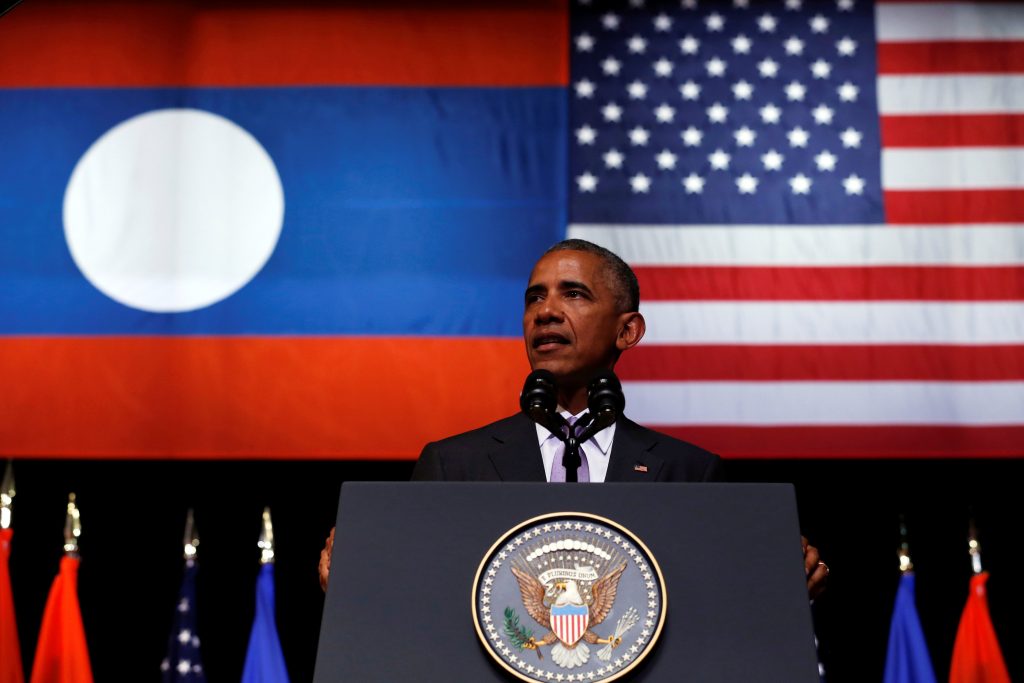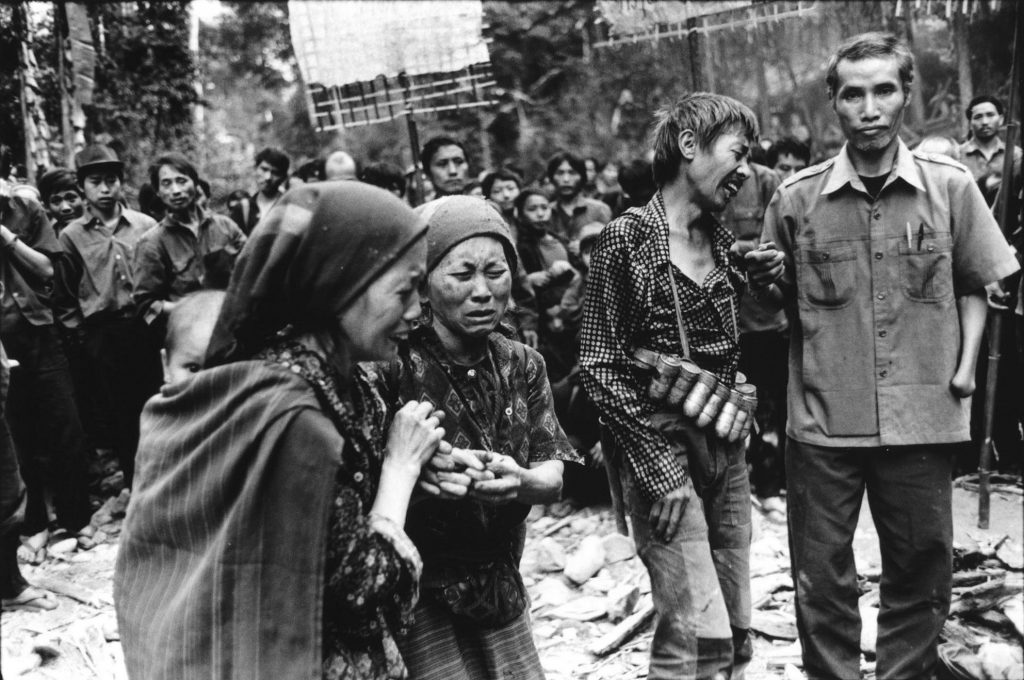Jonathan Ernst/Reuters
By
Rupen Savoulian
US President Barack Obama visited the small nation of Laos in early September 2016. He is the first sitting American president to set food in that country. He did so after attending the G20 summit in China, a meeting of the largest economies and central bank officials, the purpose of which is to encourage economic and political cooperation to stabilise and strengthen the capitalist system.
Laos was one of the invitees to the 2016 G20 summit. It is always encouraging when economically smaller nations, such as Laos, are recognised as growing in importance, and are invited to further their integration into the international community. Obama visited Laos specifically to welcome the Vientiane government, and boost bilateral ties between the two nations. This is all very well and good, but it does raise serious questions about the role of the United States in South Asia.
American investments and influence in Asia was acquired, not by peaceful means of trade and economic ties alone, but by waging criminal wars of aggression to carve out spheres of influence at the cost of millions of lives and casualties. This is illustrated no better than anywhere else than by the experience of Laos. In the context of the American war on Vietnam throughout the 1960s, Laos was also targeted by the US authorities. It is true that Laos, like Vietnam at the time, was experiencing a civil war between the Royal government, backed by the imperialist states, and the Pathet Lao, the nationalist and Communist political movement which was eventually supported by the former USSR and China. Laos became a battleground state, locked into the Cold War, in much the same way as Vietnam. Successive attempts to establish a Pathet Lao regime were undermined by the secretive political machinations of the West, cooperating with the Laotian Royalist forces. When these intrigues failed, the United States turned to a devastating, but no less secretive, type of warfare.
From 1964 to 1973, the United States air force dropped at least two millions tonnes of bombs on the nation of Laos, conducting 580,000 missions over the population of 6.8 million people. That effort means that a planeload of bombs was dropped on Laos every eight minutes, 24 hours a day, for nine years. Laos became the most heavily bombed country per capita in the world. This counterinsurgency effort was undertaken ostensibly to disrupt the supply lines of the North Vietnamese inside Laos, and bring further pressure on North Vietnamese forces. Actually, this aerial bombing campaign was part of the secret war, the CIA-sponsored programme of regime change, intended to establish a friendly pro-Western government in the country. The Americans had taken over from the French in trying to subdue the anti-colonial and nationalistic movements for independence, not only in Laos, but also throughout Indochina. The bombings killed thousands, displaced many more – villages and towns were completely destroyed, the landscape left a cratered desolate wasteland. Areas of farmland were rendered useless and uninhabitable – more tonnage was dropped on Laos than on Germany by the Americans during World War Two.
The CIA and American authorities were heavily involved in all aspects of the Laotian fighting – the Royal Laotian army was trained by US personnel, CIA operatives armed and trained anti-Communist guerrillas from among the Hmong tribespeople, supplementing them with mercenaries from Thailand, Taiwan, South Korea and the Philippines. The Hmong guerrillas, assisted and abetted by the CIA, funded their activities with the production and sale of opium. Countless thousands were not only displaced by the aerial war, but had their lives ruined by the outflow of heroin as part of this secret war. It was a secret war for the American (and Australian) populations, but not for the Laotians who endured this suffering.
Photo – Philip Blenkinsop
Laos is still coping with the trauma of that war, with unexploded ordnance (UXO) dotting the countryside. Close to half the country is contaminated by UXO, and thousands have been maimed and killed long after the war and foreign invasion ended in 1975. In June 2014, Democracy Now published the stories of those who are living with the deadly legacy of the American bombing. The Democracy Now team spoke with Thoummy Silamphan, a bomb accident survivor from Laos, who explained what happened on that fateful day when as an eight year old, he went out to collect bamboo shoots:
THOUMMY SILAMPHAN: One day, I needed to find some bamboo shoots for to feed my family, to make soup. So—and when I saw the bamboo shoots, and I tried to dig into bamboo shoots. After that, the bombie explode to me.
AMY GOODMAN: What you call a “bombie,” like a bomblet, exploded?
THOUMMY SILAMPHAN: Yes, because at that time in my village or in those areas, we have a lot of the bombing, and we don’t know the bomb under ground. And when we’re digging for bamboo shoots, and then the UXO explode to me, yeah. And it get—I lost my left hand. And that time, it’s very, very difficult for me to continue my life.
The Legacies of War web site summarises some of the startling realities that Laotians must contend with in their everyday lives, surviving in the dark shadow of this criminal American war on their country. For instance:
-
Between 1993 and 2016, the U.S. contributed on average $4.9M per year for UXO clearance in Laos; the U.S. spent $13.3M per day (in 2013 dollars) for nine years bombing Laos.
-
In just ten days of bombing Laos, the U.S. spent $130M (in 2013 dollars), or more than it has spent in clean up over the past 24 years ($118M).
In a way, the United States is still terrorizing Laos, by not providing sufficient funds and resources to adequately clean up the Laotian countryside and detoxify it in order to make it at least livable again. This malignant neglect has got to stop. This lack of funding reflects the grotesque priorities of a decaying social and economic system – boosting funding for large banking and financial institutions to stabilise the terminally ill system; neglecting the ecological and human costs of wars that are the products of that system.
President Obama, when speaking during his Laotian visit, expressed regrets about the consequences of the bombing campaign, and pledged 90 million dollars to help remove unexploded ordnance and cluster bombs from the country. That is all well and good, but it does leave us with two relevant observations to make; firstly, 90 million is still a pittance given the scale of the cleanup, and the horrific barbarism of the bombing visited upon the Laotian nation. Back in 2010, Brett Dakin, writing about this issue in The Guardian newspaper, stated that:
So far, the US has contributed an average of about $3m a year to bomb removal efforts in Laos. In contrast, the US spent more than $2m a day (about $17m in today’s dollars) for nine years dropping the bombs in the first place. The US can, and should, do more.
The state department must make a sustained commitment to solving this problem, starting with an allocation of at least $7m next year for the removal of unexploded ordnance in Laos. According to the department’s own weapons removal and abatement experts, this would dramatically reduce the impact of unexploded ordnance in Laos. A modest increase in funding would have an enormous impact for the people who live among the hidden remnants of the Vietnam war in Laos.
The horrific legacy of the US assault on Laos (and Vietnam) is still afflicting the people in that region until today. Millions lives in fear of their lives from the unexploded cluster bombs that litter the countryside. These cluster munitions are particularly lethal weapons because they contain multiple sub-munitions within one canister. The main ordnance disperses its payload over a wide area, causing casualties and injuries indiscriminately. Until today, the United States still uses, and trades in, cluster munitions.
The trade in cluster munitions brings us to the second relevant observation; while it is commendable that Obama has acknowledged the Lao victims of the US bombing, his administration is still creating more war victims. That is the point made by the writer and historian Jeremy Kuzmarov, in an article published in the Huffington Post. He wrote that the aerial and CIA-war on Laos provided a disturbing template for the current war on terror, a war that Obama has maintained and escalated throughout his years in office. As Kuzmarov observes:
The U.S. pioneered weapons systems in Laos such as drone surveillance and electronic ground censors connected to computerized bomb targeting centers that are a feature of the so-called revolution in military affairs guiding U.S. operations in the Middle East.
The U.S. government strategy in Laos was to subcontract counterinsurgency to proxy forces and rely heavily on Special Forces units and air power in the absence of regular ground troops while censoring media coverage. The manipulation of public opinion was epitomized by the fabrication of a story of a North Vietnamese invasion, during the monsoon season no less, when the roads were actually impassable.
Yes, the Obama administration changed the rhetoric surrounding the war on terror, referring to it as ‘overseas contingency operations’ (OCO). However, the content and substance has remained the same. Obama, throughout his two terms in office, has done nothing but escalate American military operations, deployment of US special forces, expand drone surveillance and warfare, and pivot increasingly to Asia, securing alliances with countries that can serve as allies in any potential conflict with China. Obama’s Laotian visit can be understood within the context of this pivot to Asia. Obama’s motivations to set foot in Vientiane is not just to spread a charm offensive, but also tactical – Laos is a potential gateway to Southeast and East Asia.
Laos has been getting on with rebuilding its country – after the end of the Laotian war in 1975, it was the former USSR that assisted in rebuilding the country from scratch, providing technical and financial assistance. Laos remains dependent on Chinese and Russian investment, though it has been steadily opening up to Western investment. The United States would like to claim a stake in the Laotian economy, and Obama’s historic visit is the first step in that endeavour. It is one thing to remember the Lao victims of the American bombing. However, Obama shows a perverse disregard for the Laotian casualties of that war and its lethal legacy by adopting the central doctrines of aerial bombardment and war by proxy – the very tactics developed by those responsible for bringing calamity on that country. It is time for the Obama administration to be held accountable for the war victims that it creates.




No Comments Yet!
You can be first to comment this post!